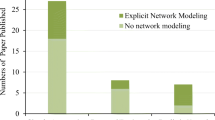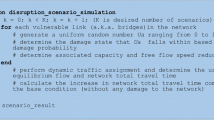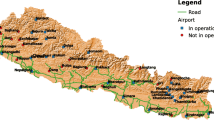Abstract
In recent years, the frequency and severity of catastrophic events triggered by natural hazards have increased. Meanwhile, man-made hazards, such as terrorist attacks, and their impacts on infrastructure systems have gained increasing attention. These hazards (both natural and man-made) can cause catastrophic physical damage to transportation infrastructure systems that are essential to the wellbeing of the society. Moreover, the direct economic losses (e.g., physical damage to infrastructure) diffuse and expand continually through the disruption of economic activities between different regions and industries, resulting in enormous and complex indirect losses. A comprehensive investigation of total losses, including direct and indirect losses, requires the use of economic impact analysis models. However, most of the economic impact analysis methods and models introduced in the existing literature fail to incorporate the spatially distributed and networked nature of transportation infrastructures. To achieve a comprehensive and a realistic understanding of the economic impacts caused by the disturbances to the transportation infrastructure, the spatial distribution and the networked nature of transportation systems has to be accounted for, and realistic and locally relevant hazard scenarios must be incorporated into the economic analyses. This paper first provides a detailed account of the status-quo in economic modeling associated with impact analysis of transportation disturbances to identify the gaps in this domain. Next, focusing on the commuting related economic impacts of transportation disturbances as an example, the paper introduces a multidisciplinary framework designed to demonstrate an understanding on how to address the gaps. Preliminary results from a Los Angeles case study are presented.
Access this chapter
Tax calculation will be finalised at checkout
Purchases are for personal use only
Similar content being viewed by others
Notes
- 1.
We assume that most critical components of the transportation network are its bridges. This is well established by the literature in transportation safety.
- 2.
Earthquakes present a different opportunity for economic impact analysis than some of the other hazards. This is due to the advanced ability of scientists to forecast the impact of these events which gives way to policy initiatives directed to mitigation [50].
- 3.
The economic region in the full deployment of the framework will be the regions in Los Angeles that we have the input-output table for.
- 4.
These values are published annually by Bureau of Transportation Statistics. Average cost of driving includes fuel, maintenance, and tires. Available online at: www.rita.dot.gov/bts.
- 5.
The Vehicle Operation Cost Parameters are statewide representative average values recommended by California Department of Transportation [60] to be used in the economic analysis of highway and other projects.
References
Tatano, H., Tsuchiya, S.: A framework for economic loss estimation due to seismic transportation network disruption: a spatial computable general equilibrium approach. Nat. Hazards 44, 253–265 (2008)
Cochrane, H.C.: Predicting the Economic Impacts of Earthquakes (1974)
Hallegatte, S.: An adaptive regional input-output model and its application to the assessment of the economic cost of Katrina. Risk Anal. 28, 779–799 (2008)
Park, J., Gordon, P., Kim, S., Kim, Y., Moore, J.E.I., Richardson, H.W.: Estimating the State-by-State Economic Impacts of Hurricane Katrina (2005)
Park, J.Y., Gordon, P., Moore, J.S.E., Richardson, H.W.: The state-by-state economic impacts of the 2002 shutdown of the Los Angeles-Long Beach ports. Growth Change 39, 548–572 (2008)
Rose, A.: Defining and measuring economic resilience to disasters. Disaster Prev. Manag. Int. J. 13, 307–314 (2004)
Rose, A., Liao, S.Y.: Modeling regional economic resilience to disasters: a computable general equilibrium analysis of water service disruptions. J. Reg. Sci. 45, 75–112 (2005)
Crowther, K.G., Haimes, Y.Y., Taub, G.: Systemic valuation of strategic preparedness through application of the inoperability input-output model with lessons learned from Hurricane Katrina. Risk Anal. 27, 1345–1364 (2007)
Aloughareh, I.R., Ashtiany, M.G., Nasserasadi, K.: An integrated methodology for regional macroeconomic loss estimation of earthquake: a case study of Tehran. Singap. Econ. Rev. 61, 1550025 (2016)
Koks, E.E., Thissen, M.: A multiregional impact assessment model for disaster analysis. Econ. Syst. Res. 28, 429–449 (2016)
Koks, E.E., Carrera, L., Jonkeren, O., Aerts, J.C.J.H., Husby, T.G., Thissen, M., Standardi, G., Mysiak, J.: Regional disaster impact analysis: comparing input-output and computable general equilibrium models. Nat. Hazards Earth Syst. Sci. 16, 1911–1924 (2016)
Oztanriseven, F., Nachtmann, H.: Economic impact analysis of inland waterway disruption response. Eng. Econ. 62, 73–89 (2017)
Lian, C., Halmes, Y.Y.: Managing the risk of terrorism to interdependent infrastructure systems through the dynamic inoperability input-output model. Syst. Eng. 9, 241–258 (2006)
Li, J., Crawford-Brown, D., Syddall, M., Guan, D.: Modeling imbalanced economic recovery following a natural disaster using input-output analysis. Risk Anal. 33, 1908–1923 (2013)
Park, J., Gordon, P., Ii, J.E.M., Richardson, H.W.: Simulating the State-by-State Effects of Terrorist Attacks on Three Major U.S. Ports: Applying NIEMO (National Interstate Economic Model) (2005)
Park, J.Y.: The economic impacts of dirty- bomb attacks on the los angeles and long beach ports: applying the supply-driven NIEMO (national interstate economic model). J. Homel. Secur. Emerg. Manag. 5, Article 21 (2008)
Wei, H., Dong, M., Sun, S.: Inoperability input-output modeling (IIM) of disruptions to supply chain networks. Syst. Eng. 13, 324–339 (2010)
Gueler, C.U., Johnson, A.W., Cooper, M.: Case study: energy industry economic impacts from ohio river transportation disruption. Eng. Econ. 57, 77–100 (2012)
Tan, X.M., Zhang, Y., Lam, J.S.L.: Economic impact of port disruptions on industry clusters: a case study of Shenzhen. In: Yan, X.P., Hu, Z.Z., Zhong, M., Wu, C.Z., Yang, Z. (eds.) 3rd International Conference on Transportation Information and Safety (ICTIS 2015), pp. 617–622. IEEE, New York (2015)
Zhang, Y., Lam, J.S.L.: Estimating economic losses of industry clusters due to port disruptions. Transp. Res. Part A-Policy Pract. 91, 17–33 (2016)
Rose, A., Wei, D.: Estimating the economic consequences of a port shutdown: the special role of resilience. Econ. Syst. Res. 25, 212–232 (2013)
Santos, J.R., Haimes, Y.Y.: Modeling the demand reduction input-output (I-O) inoperability due to terrorism of interconnected infrastructures. Risk Anal. 24, 1437–1451 (2004)
Pant, R., Barker, K., Grant, F.H., Landers, T.L.: Interdependent impacts of inoperability at multi-modal transportation container terminals. Transp. Res. Part E Logist. Transp. Rev. 47, 722–737 (2011)
Thekdi, S.A., Santos, J.R.: Supply chain vulnerability analysis using scenario-based input-output modeling: application to port operations. Risk Anal. 36, 1025–1039 (2016)
Irimoto, H., Shibusawa, H., Miyata, Y.: Evaluating the economic damages of transport disruptions using a transnational and interregional input-output model for Japan, China, and South Korea. In: AIP Conference Proceedings, p. 110002 (6 p.). AIP - American Institute of Physics, College Park (2017)
Ueda, T., Koike, A., Iwakami, K.: Economic damage assessment of catastrophes in high speed rail network. In: Proceedings of 1st Workshop for Comparative Study on Urban Earthquake Disaster Management, pp. 13–19 (2001)
Thissen, M.: The indirect economic effects of a terrorist attack on transport infrastructure: a proposal for a SAGE. Disaster Prev. Manag. 13, 315–322 (2004)
Jaiswal, P., Van Westen, C.J., Jetten, V.: Quantitative assessment of direct and indirect landslide risk along transportation lines in southern India. Nat. Hazards Earth Syst. Sci. 10, 1253–1267 (2010)
Kajitani, Y., Chang, S.E., Tatano, H.: Economic Impacts of the 2011 Tohoku-oki earthquake and tsunami. Earthq. Spectra. 29, S457–S478 (2013)
MacKenzie, C., Santos, J., Barker, K.: Measuring changes in international production from a disruption: case study of the Japanese earthquake and tsunami. Int. J. Prod. Econ. 138, 293–302 (2012)
Tokui, J., Kawasaki, K., Miyagawa, T.: The economic impact of supply chain disruptions from the Great East-Japan earthquake. Japan World Econ. 41, 59–70 (2017)
Xie, W., Li, N., Li, C., Wu, J.D., Hu, A., Hao, X.: Quantifying cascading effects triggered by disrupted transportation due to the Great 2008 Chinese Ice Storm: implications for disaster risk management. Nat. Hazards 70, 337–352 (2014)
Yu, K.D.S., Tan, R.R., Santos, J.R.: Impact estimation of flooding in manila: an inoperability input-output approach. In: 2013 IEEE Systems and Information Engineering Design Symposium (SIEDS), pp. 47–51. IEEE, New York (2013)
Zhang, Y., Lam, J.S.L.: Estimating the economic losses of port disruption due to extreme wind events. Ocean Coast. Manag. 116, 300–310 (2015)
Rose, A., Sue Wing, I., Wei, D., Wein, A.: Economic impacts of a California Tsunami. Nat. Hazards Rev. 17, 4016002 (2016)
Xie, F., Levinson, D.: Evaluating the effects of the I-35W bridge collapse on road-users in the twin cities metropolitan region. Transp. Plan. Technol. 34, 691–703 (2011)
Omer, M., Mostashari, A., Nilchiani, R.: Assessing resilience in a regional road-based transportation network. Int. J. Ind. Syst. Eng. 13, 389–408 (2013)
Ashrafi, Z., Shahrokhi Shahraki, H., Bachmann, C., Gingerich, K., Maoh, H.: Quantifying the criticality of highway infrastructure for freight transportation. Transp. Res. Rec. J. Transp. Res. Board 2610, 10–18 (2017)
Tsuchiya, S., Tatano, H., Okada, N.: Economic loss assessment due to railroad and highway disruptions. Econ. Syst. Res. 19, 147–162 (2007)
Kim, E., Kwon, Y.J.: Indirect impact of nuclear power plant accidents using an integrated spatial computable general equilibrium model with a microsimulation module on the Korean transportation network. In: Kim, E., Kim, B.H.S. (eds.) Quantitative Regional Economic and Environmental Analysis for Sustainability in Korea. NFRSAP, vol. 25, pp. 141–152. Springer, Singapore (2016). https://doi.org/10.1007/978-981-10-0300-4_8
Park, J., Cho, J., Gordon, P., Moore II, J.E., Richardson, H.W., Yoon, S.: Adding a freight network to a national interstate input-output model: a TransNIEMO application for California. J. Transp. Geogr. 19, 1410–1422 (2011)
Cho, J.K., Gordon, P., Moore, J.E., Pan, Q., Park, J.Y., Richardson, H.W.: TransNIEMO: economic impact analysis using a model of consistent inter-regional economic and network equilibria. Transp. Plan. Technol. 38, 483–502 (2015)
Mesa-Arango, R., Zhan, X., Ukkusuri, S.V., Mitra, A.: Direct transportation economic impacts of highway networks disruptions using public data from the United States. J. Transp. Saf. Secur. 8, 36–55 (2016)
Torrey, W.F.: Estimating the cost of congestion to the trucking industry standardized methodology for congestion monitoring and monetization. Transp. Res. Rec. 57–67 (2017)
Tirasirichai, C., Enke, D.: Case study: applying a regional CGE model for estimation of indirect economic losses due to damaged highway bridges. Eng. Econ. 52, 367–401 (2007)
Enke, D.L., Tirasirichai, C., Luna, R.: Estimation of earthquake loss due to bridge damage in the St. Louis metropolitan area. II: indirect losses. Nat. Hazards Rev. 9, 12–19 (2008)
Chen, G., Anderson, N., Luna, R., Stephenson, R., El-Engebawy, M., Silva, P., Zoughi, R., Hoffman, D., Enke, D., Rogers, D.: Assessment and Mitigation of New Madrid Earthquake Hazards to Transportation Structure Systems (2005)
Cho, S., Gordon, P., Moore, J.E., Richardson, H.W., Shinozuka, M., Chang, S.: Integrating transportation network and regional economic models to estimate the costs of a large urban earthquake. J. Reg. Sci. 41, 39–65 (2001)
Gordon, P., Moore II, J.E., Richardson, H.W., Shinozuka, M., An, D., Cho, S.: Earthquake disaster mitigation for urban transportation systems: an integrated methodology that builds on the Kobe and Northridge experiences. In: Okuyama, Y., Chang, S.E. (eds.) Modeling Spatial and Economic Impacts of Disasters, pp. 205–232. Springer, Heidelberg (2004). https://doi.org/10.1007/978-3-540-24787-6_11
Sohn, J., Kim, T.J., Hewings, G.J.D., Lee, J.S., Jang, S.G.: Retrofit priority of transport network links under an earthquake. J. Urban Plan. Dev. 129, 195–210 (2003)
Postance, B., Hillier, J., Dijkstra, T., Dixon, N.: Extending natural hazard impacts: an assessment of landslide disruptions on a national road transportation network. Environ. Res. Lett. 12, 014010 (2017)
Evangelos, S., Kiremidjian, A.S.: Treatment of Uncertainties in Seismic Risk Analysis of Transportation Systems (2006)
Tirasirichai, C.: An indirect loss estimation methodology to account for regional earthquake damage to highway bridges. ProQuest dissertations theses, p. 147 (2007)
Ghosh, A.: Input-output approach in an allocation system. Economica XXV, 58–64 (1958)
Leontief, W.: Quantitative input and output relations in the economic systems of the United States. Rev. Econ. Stat. 18, 105–125 (1936)
Oosterhaven, J.: On the plausibility of the supply-driven input-output model. J. Reg. Sci. 28, 203–217 (1988)
Dietzenbacher, E.: In vindication of the Ghosh model: a reinterpretation as a price model. J. Reg. Sci. 37, 629–651 (1997)
Koc, E., Akhavan, A., Castro, E., Cetiner, B., Soibelman, L., Wang, Q., Taciroglu, E.: Framework for coupled assessment of human mobility and infrastructure resilience under extreme events (in review). J. Comput. Civ. Eng. Spec. Collect. Comput. Approaches Enable Smart Sustain. Urban Syst. (2018)
CTPP, Census Transportation Planning Products. http://ctpp.transportation.org/Pages/5-Year-Data.aspx. Accessed 19 Mar 2018
California Department of Transportation, Vehicle Operation Cost Parameters. http://www.dot.ca.gov/hq/tpp/offices/eab/benefit_cost/LCBCA-economic_parameters.html. Accessed 19 Mar 2018
Minnesota IMPLAN Group (MIG), Impact Analysis for Planning (IMPLAN) System. http://www.implan.com. Accessed 19 Mar 2018
Acknowledgements
This material is based upon work supported by National Key R&D Program of China under grant No. 2017YFC0803308, National Natural Science Foundation of China (NSFC) under grant No. U1709212, 71741023, and Tsinghua University Initiative Scientific Research Program under grant No. 2014z21050 and 2015THZ0. The authors are thankful for the support of Ministry of Science and Technology of China, NSFC and Tsinghua University. Any opinions, findings, and conclusions or recommendations expressed in this paper are those of the authors and do not necessarily reflect the views of the funding agencies.
Author information
Authors and Affiliations
Corresponding author
Editor information
Editors and Affiliations
Rights and permissions
Copyright information
© 2018 Springer International Publishing AG, part of Springer Nature
About this paper
Cite this paper
Wei, F., Koc, E., Soibelman, L., Li, N. (2018). Disaster Economics and Networked Transportation Infrastructures: Status Quo and a Multi-disciplinary Framework to Estimate Economic Losses. In: Smith, I., Domer, B. (eds) Advanced Computing Strategies for Engineering. EG-ICE 2018. Lecture Notes in Computer Science(), vol 10864. Springer, Cham. https://doi.org/10.1007/978-3-319-91638-5_1
Download citation
DOI: https://doi.org/10.1007/978-3-319-91638-5_1
Published:
Publisher Name: Springer, Cham
Print ISBN: 978-3-319-91637-8
Online ISBN: 978-3-319-91638-5
eBook Packages: Computer ScienceComputer Science (R0)




